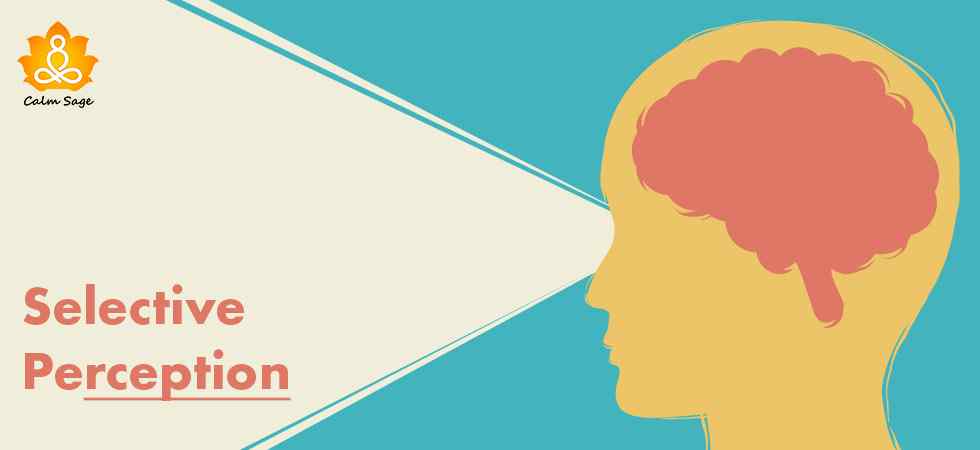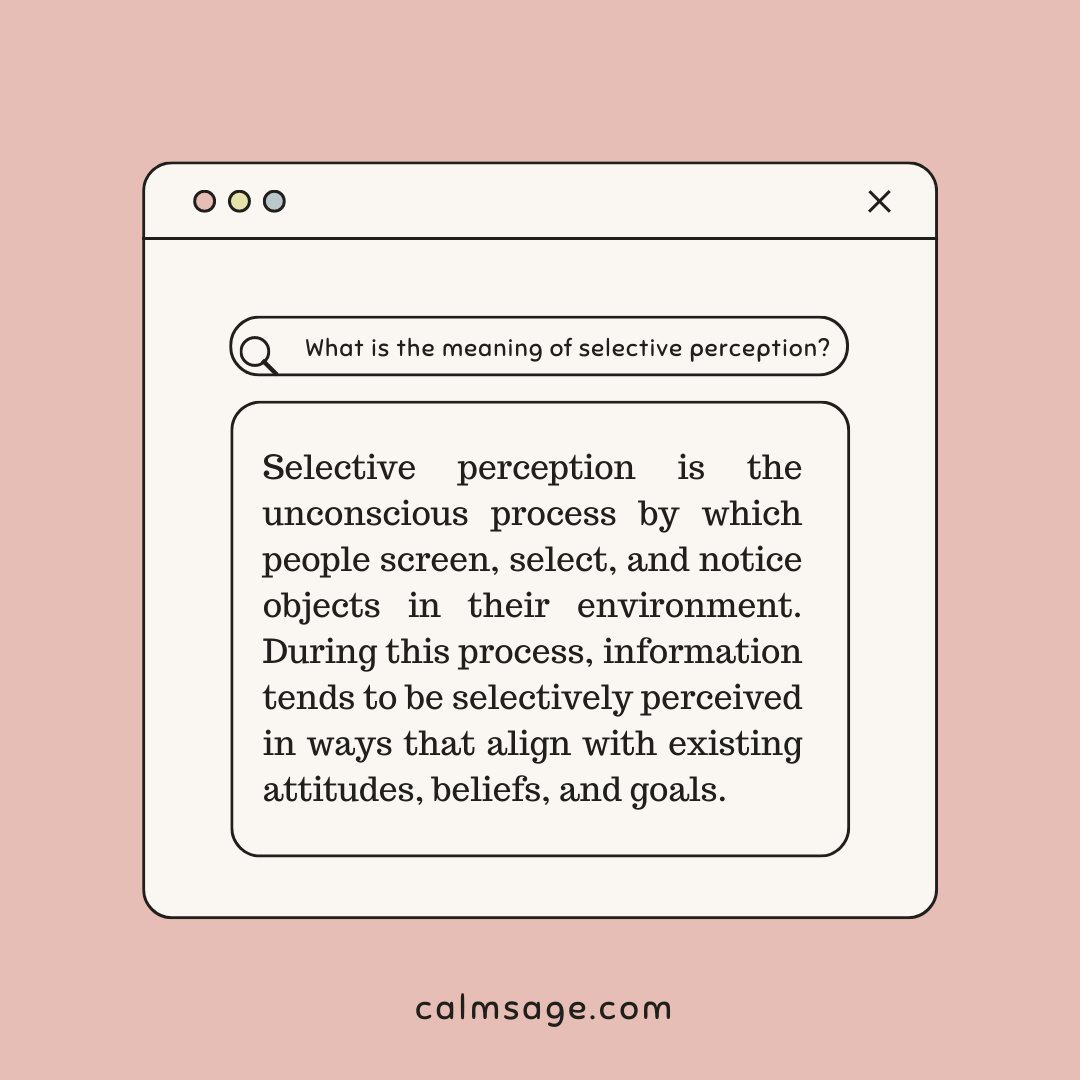What is Selective Perception: Definition, Types & Examples

Have you ever been in a situation where you thought you were completely right, when you simply ignored all the red flags that were telling you otherwise? If yes, that’s selective perception. Selective perception is a cognitive distortion which makes you ignore information around you and shifts your attention to things your mind tells you to.
What does the mind tell you? Our mind is indeed very cunning. In the case of selective perception, your kind will pull strings from your preconceived thoughts, expectations, past experiences, values, desires, etc., and will divert your attention to specifically these things and not to the information available to you at the ground.
Selective perception, just like selective mutism, stops you from a free and unbiased comprehension and use of your perception. Selective mutism is governed by your anxiety and selective perception is governed by a distortion in your cognitive abilities.
Let’s explore a little more about selective perception
Selective Perception: Definition
Selective perception is a mental process which makes you pay attention to things you feel are right, completely ignoring the indicators of you being wrong. You very conveniently ignore things that aren’t in favor of what you feel is right.
Selective perception can also take place in case of the presence of stimulus that triggers emotional discomfort. You choose to ignore or easily forget about the things that are capable of causing you emotional pain or discomfort.
For example, you completely ignore the fact that you had an argument with your partner only because you are scared of an emotionally draining confrontation.
Selective Perception Theory

The selective perception theory states that we select, categorize and analyze the various stimuli around us, to add meaning to things happening around us. While we are in the process of forming meaningful experiences, through selective perception we ignore all the stimuli that do not fit in or contradict our beliefs, values, desires or expectations.
The selective perception theory basically states that we have the ability to consciously or unconsciously ignore certain stimuli while we perceive things around us. Conscious selective perception looks like ignoring certain colors or photographs or even sound for that matter. Whereas unconscious selective perception is when your brain blocks information based on your past experiences, beliefs and desires.
Selective perception: Psychology
The psychology behind selective perception is that you have a tendency to perceive only those things that excite you and don’t pay attention to any information that is pointing out the opposite. Selective perception psychology tells us that the process of optimizing our resources (cognitive) and shifting focus only to those things that we expect to happen is called selective perception.
Selective perception psychology also answers, “Why would someone engage in selective perception?” you engage in selective perception (consciously or unconsciously) only when certain stimuli are disturbing and difficult to handle and have the ability to because you pain, disappointment or discomfort.
Selective perception is also one of the guiding forces that make you ignore your disturbing feelings and thoughts. It stops you from confronting your own feelings and emotions which lead you to developing various mental health related illnesses and issues like anxiety, depression, unresolved trauma, etc.

Selective Perception Types
There are two types of selective perception, namely, perceptual vigilance and perceptual defense. Let’s give them a quick look;
1. Perceptual vigilance: this selective perception type is when your selective perception is not very high in degree. Perceptual vigilance is referred to the process of identifying or recognizing all those stimuli that in some way or the other are significant to you.
2. Perceptual defense: this type of selective perception is a process of ignoring or creating barriers in between you and certain stimuli that you think are potential threats to you. You do this to protect yourself by alienating yourself from certain information or stimuli.
Also read: What Is Hallucinogen Persisting Perception Disorder? Is It Curable
Selective Perception Examples
If you have read this far, I’m sure you must have completely understood what selective. Here are a few examples of selective perception which will clear all remaining doubts you may have about this concept.
Examples 1. you are left in charge of selecting a team for a soccer game coming up next week which you need to win by all means. The team can be a combination of both boys and girls and you end up selecting more boys than girls only because you expect boys to be better than girls in soccer. That’s selective perception based on your expectations, beliefs or even bias
Examples 2. The placebo effect is one of the best examples of selective perception. Do you recollect a time when you were ill and even having a meeting with the doctor made you feel better? It’s because you expect to heal or to be cured in a hospital. That’s again selective perception.
Examples 3. For example you have had cough or fever for a week now and you put it on the weather or say that you can taste and smell things just to avoid getting yourself tested for Covid and having the report to be positive. This is also selective perception, to be specific it is a type of selective perception, perceptual defense.
Examples 4. For example, in order to avoid completing your assignment you keep yourself busy in doing other things by telling yourself that they are more important than your assignments. This is again a very simple example of selective perception.
Is Selective Perception Good or Bad?
Selective perception is a two-way process. It has its benefits and drawbacks, depending on the context. Here are some pros and cons of selective perception that you need to consider;
Pros:
- Selective perception can help you focus on the most relevant information, filtering out unnecessary information, and leading to a more efficient decision-making process.
- When you learn to filter out overwhelming information, you reduce cognitive overload and stress.
- This process can also help you maintain a positive outlook by focusing on the positive aspects and ignoring the negative ones.
Cons:
- Selective perception can cause bias and can reinforce existing biases, beliefs, and prejudices.
- You can also miss out on important information, leading to missed opportunities and poor decision-making.
- Different perspectives can cause misunderstandings and conflicts, especially when you work in a group and collaborative setting.
Why is Selective Perception Important?
Selective perception is important because it influences how you interpret and interact with the world around you. It helps your brain manage and process sensory information that you experience daily and focus on what’s relevant. This process also helps shape how you make your decisions by highlighting specific information while disregarding others.
Selective perception can also help form and reinforce attitudes, beliefs, and behaviors by focusing attention on information that aligns with existing views. Moreover, you can improve communication and reduce misunderstandings in relationships with the help of selective perception.
How to Avoid Selective Perception?
In some situations, selective perception can go against you, so when such situations arise, here are some ways you can avoid selective perception;
- Recognize and acknowledge: You need to identify and accept that selective perception exists. Understanding the biases and how they can affect your perception and decisions can help.
- Understand new perspectives: Try to view other perspectives and look for new sources of information that challenge your preconceptions and existing beliefs.
- Think critically: Analyze the information you gather with a critical eye. Question assumptions and make sure you evaluate all evidence objectively.
- Practice mindfulness: Engage in mindfulness techniques to become more aware of your present without judgment. This will help you focus on what you need
- Learn from others: Seek feedback from others to understand others’ perspectives. This can help you avoid selective perception and correct any biases you may have.
- Reflect on yourself: Try to engage in self-reflection activities and reflect on your decisions. This can help you identify and address any bias you may have or selective perceptions.
That’s All Folks!
I hope you found this blog about selective perceptions interesting and informative. Do share this blog with your friends and family so that we can all keep a check on our selective perceptions and don’t let this cognitive distortion make us take the road to declining mental health.
Thanks for reading.
Take care and stay safe.
Next Read:
9 Daily Habits You Should Adopt To Make Better Decisions In Life




















